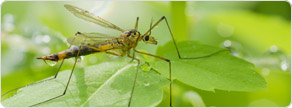
You aren’t the only one eager to feast on your homegrown produce. Insects also target your edible spread. Outsmarting pests begins with knowing your enemy, including telltale signs that pests are active in the garden.
The best time to scout for problems is when you’re tending crops. Not sure what to look for? Use this guide to common edible pests to increase your vegetable pest IQ.
Slugs and snails
Voracious appetites accompany these slimy pests to the garden. They’re not picky about their menu; they’ll feed on nearly any plant. In spring, they destroy lettuce seedlings in short order and mow down carrot and beet tops.
Later in the season, these chewing machines leave narrow trails on fruit, such as strawberries, tomatoes and eggplant. Staking tomatoes keeps fruit beyond the reach of hungry slugs. These pests feed at night or on cloudy days. If you suspect slugs, slip outside after dark with a flashlight to inspect plants.
Other signs of slugs and snails: seedlings that disappear; half-eaten leaves; trails in ripening fruit
Aphids
These sucking insects appear early in the season, long before your first harvest. Aphids are oval-shaped, small and light-green, black or pinkish. They reproduce rapidly: One day seedlings look fine; the next, stems appear covered. Typically aphids prefer new growth on plants and seedlings. They’re equal opportunity pests, attacking just about any crop.
Aphids suck the juices out of new shoots, buds and leaves. They produce honeydew, a sweet, sticky substance that hosts black sooty mold and attracts ants. If you miss the pests clustered along new growth, you may see black mold or ants racing up and down stems.
Other signs of aphids: curled, stunted or puckered leaves; yellowing leaves that fall from stems
Cabbage loopers and worms
Two caterpillar-like pests, cabbage loopers and cabbage worms, infest cabbage family crops, including broccoli, Brussels sprouts, cauliflower and cabbage. Loopers earn their name because they arch (loop) their backs as they inch along. Both worms are green.
Worms chew leaf edges and ragged-edged holes in leaves. They hide on leaf undersides and inside developing heads or growing points of plants.
Other signs of cabbage worms and loopers: small white moths fluttering around plants (these moths lay eggs that turn into the worms); small, dark pellets of frass (fecal matter) on leaves, which grow larger as worms increase in size
Mexican bean beetles
Beans are the crop of choice for these chewing pests. Similar in size and shape to ladybugs, Mexican bean beetles display a coppery color with black spots. Young forms lack spots.
Larvae have soft bodies with a spiny appearance. They feed beneath leaves, munching on bean leaves and pods. When feeding is heavy, leaves become skeletonized. Only veins remain intact; the spaces between become dry, brown and fall away.
Other signs of Mexican bean beetles: clusters of oblong yellow eggs beneath leaves; small holes in leaves (as damage starts); holes in ripening bean pods
Tomato hornworm
Despite its large size (up to 5 inches long), this worm is easy to miss in the tomato patch. The distinct green worms have white streaks and eye-like spots on their bodies, as well as a red or black tail. They feed mainly on tomato plant leaves, but will feast on other tomato family crops, such as eggplant or potato.
Worms hide beneath leaves during the day, emerging to feed at dusk or on cloudy days. Entire leaves disappear overnight, and as worms mature, they also consume ripening tomatoes.
Other signs of tomato hornworm: presence of hummingbird, or sphinx, moths, the parent of this worm (if you spy these hovering around tomatoes, inspect plants frequently for worms); small, dark pellets of frass (fecal matter) on leaves, which grow larger as worms increase in size

